
Archery is the sport, practice, or skill of using a bow to shoot arrows. The word comes from the Latin arcus, meaning bow. Historically, archery has been used for hunting and combat. In modern times, it is mainly a competitive sport and recreational activity. A person who practices archery is typically called an archer, bowman, or toxophilite.

A crossbow is a ranged weapon using an elastic launching device consisting of a bow-like assembly called a prod, mounted horizontally on a main frame called a tiller, which is hand-held in a similar fashion to the stock of a long firearm. Crossbows shoot arrow-like projectiles called bolts or quarrels. A person who shoots crossbow is called a crossbowman or an arbalist.

The English longbow was a powerful medieval type of bow, about 6 ft (1.8 m) long. While it is debated whether it originated in England or Wales, by the 14th century the longbow was being used by both the English and the Welsh as a weapon of war and for hunting. English use of longbows was effective against the French during the Hundred Years' War, particularly at the start of the war in the battles of Sluys (1340), Crécy (1346), and Poitiers (1356), and perhaps most famously at the Battle of Agincourt (1415). However they were less successful after this, with longbowmen having their lines broken at the Battle of Verneuil (1424) although the English won a decisive victory, and being completely routed at the Battle of Patay (1429) when they were charged by the French mounted men-at-arms before they had prepared the terrain and finished defensive arrangements. The Battle of Pontvallain (1370) had also previously shown longbowmen were not particularly effective when not given the time to set up defensive positions.

An arrow is a fin-stabilized projectile launched by a bow. A typical arrow usually consists of a long, stiff, straight shaft with a weighty arrowhead attached to the front end, multiple fin-like stabilizers called fletchings mounted near the rear, and a slot at the rear end called a nock for engaging the bowstring. A container or bag carrying additional arrows for convenient reloading is called a quiver.

The bow and arrow is a ranged weapon system consisting of an elastic launching device (bow) and long-shafted projectiles (arrows). Humans used bows and arrows for hunting and aggression long before recorded history, and the practice was common to many prehistoric cultures. They were important weapons of war from ancient history until the early modern period, where they were rendered increasingly obsolete by the development of the more powerful and accurate firearms. Today, bows and arrows are mostly used for hunting and sports.
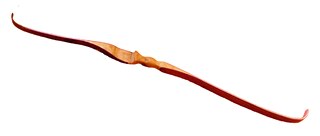
In archery, the shape of the bow is usually taken to be the view from the side. It is the product of the complex relationship of material stresses, designed by a bowyer. This shape, viewing the limbs, is designed to take into account the construction materials, the performance required, and the intended use of the bow.
The Worshipful Company of Bowyers is one of the livery companies of the City of London.

A composite bow is a traditional bow made from horn, wood, and sinew laminated together, a form of laminated bow. The horn is on the belly, facing the archer, and sinew on the outer side of a wooden core. When the bow is drawn, the sinew and horn store more energy than wood for the same length of bow. The strength can be made similar to that of all-wood "self" bows, with similar draw-length and therefore a similar amount of energy delivered to the arrow from a much shorter bow. However, making a composite bow requires more varieties of material than a self bow, its construction takes much more time, and the finished bow is more sensitive to moisture.

The Korean Bow is a water buffalo horn-based composite reflex bow, standardized centuries ago from a variety of similar weapons in earlier use. Due to its long use by Koreans, it is also known as Guk Gung. The Korean bow utilizes a thumb draw and therefore employing the use of a thumb ring is quite common. The Korean thumb ring is somewhat different from the Manchu, Mongol, or the Turkic Thumb Ring, as it comes in two styles, male and female. Male thumb rings are shaped with a small protrusion that sticks out that the bowstring hooks behind, while the female thumb ring simply covers the front joint of the thumb as protection from getting blisters.
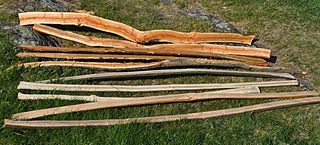
A bowyer is a master-craftsman who makes bows. Though this was once a widespread profession, the importance of bowyers and of bows was diminished by the introduction of gunpowder weaponry. However, the trade has survived and many bowyers continue to produce high-end bows.

The Mongol bow is a type of recurved composite bow used in Mongolia. "Mongol bow" can refer to two types of bow. From the 17th century onward, most of the traditional bows in Mongolia were replaced with the similar Manchu bow which is primarily distinguished by larger syiahs and the presence of prominent string bridges.
A flatbow is a bow with non-recurved, flat, relatively wide limbs that are approximately rectangular in cross-section. Because the limbs are relatively wide, flatbows will usually narrow and become deeper at the handle, with a rounded, non-bending handle for easier grip. This design differs from that of a longbow, which has rounded limbs that are circular or D shaped in cross-section, and is usually widest at the handle. A flatbow can be just as long as a longbow, but can also be very short. Typical lengths would be 68–70 inches (172.5–178 cm) for a flatbow, 70–72 inches (178–183 cm) for an English longbow, and 72–76 inches (183–193 cm) for a warbow-weight English longbow; but these styles may easily overlap each other. Traditional flatbows are usually wooden self bows, though laminated and composite flatbows have been made in ancient and modern times. Modern flatbows commonly use fiberglass.
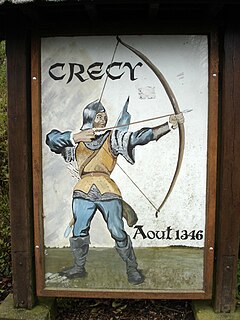
A longbow is a type of tall bow that makes a fairly long draw possible. A longbow is not significantly recurved. Its limbs are relatively narrow and are circular or D-shaped in cross section. Flatbows can be just as long, but in cross-section, a flatbow has limbs that are approximately rectangular.
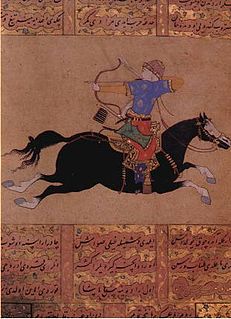
Turkish archery is a tradition of archery which became highly developed in the Ottoman Empire, although its origins date back to the Eurasian Steppe in the second millennium BC.
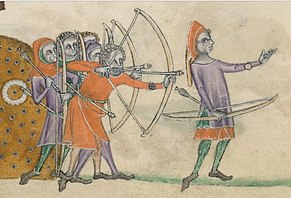
Archery, or the use of bow and arrows, was probably developed in Africa by the later Middle Stone Age. It is documented as part of warfare and hunting from the classical period until the late medieval period when it was made obsolete by the increased use of firearms.

In archery, a recurve bow is one of the main shapes a bow can take, with limbs that curve away from the archer when unstrung. A recurve bow stores more energy and delivers energy more efficiently than the equivalent straight-limbed bow, giving a greater amount of energy and speed to the arrow. A recurve will permit a shorter bow than the simple straight limb bow for given arrow energy, and this form was often preferred by archers in environments where long weapons could be cumbersome, such as in brush and forest terrain, or while on horseback.

A horse archer is a cavalryman armed with a bow and able to shoot while riding from horseback. Archery has occasionally been used from the backs of other riding animals. In large open areas, it was a highly successful technique for hunting, for protecting the herds, and for war. It was a defining characteristic of the Eurasian nomads during antiquity and the medieval period, as well as the Iranian peoples, and Indians in antiquity, and by the Hungarians, Mongols, Chinese, and the Turkic peoples during the Middle Ages. By the expansion of these peoples, the practice also spread to Eastern Europe, Mesopotamia, and East Asia. In East Asia, horse archery came to be particularly honored in the samurai tradition of Japan, where horse archery is called Yabusame.
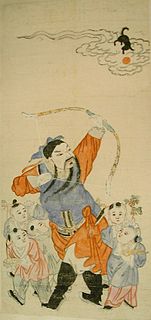
For millennia, Chinese archery has played a pivotal role in Chinese society. In particular, archery featured prominently in ancient Chinese culture and philosophy: archery was one of the Six Noble Arts of the Zhou dynasty ; archery skill was a virtue for Chinese emperors; Confucius himself was an archery teacher; and Lie Zi was an avid archer. Because the cultures associated with Chinese society spanned a wide geography and time range, the techniques and equipment associated with Chinese archery are diverse. The improvement of firearms and other circumstances of 20th century China led to the demise of archery as a military and ritual practice, and for much of the 20th century only one traditional bow and arrow workshop remained. However, at the beginning of the 21st century, there has been a revival in interest among craftsmen looking to construct bows and arrows, as well as a practice technique in the traditional Chinese style.
Charles Elbert Grayson was an archer, bowyer, archery collector, and author. His archery collection is contained in the University of Missouri Museum of Anthropology.
The Woodmen of the Ancient Forest of Arden are an exclusive society of longbow shooting toxophilites, founded in 1758 in the village of Meriden, in the Borough of Solihull, in the ancient Forest of Arden.















